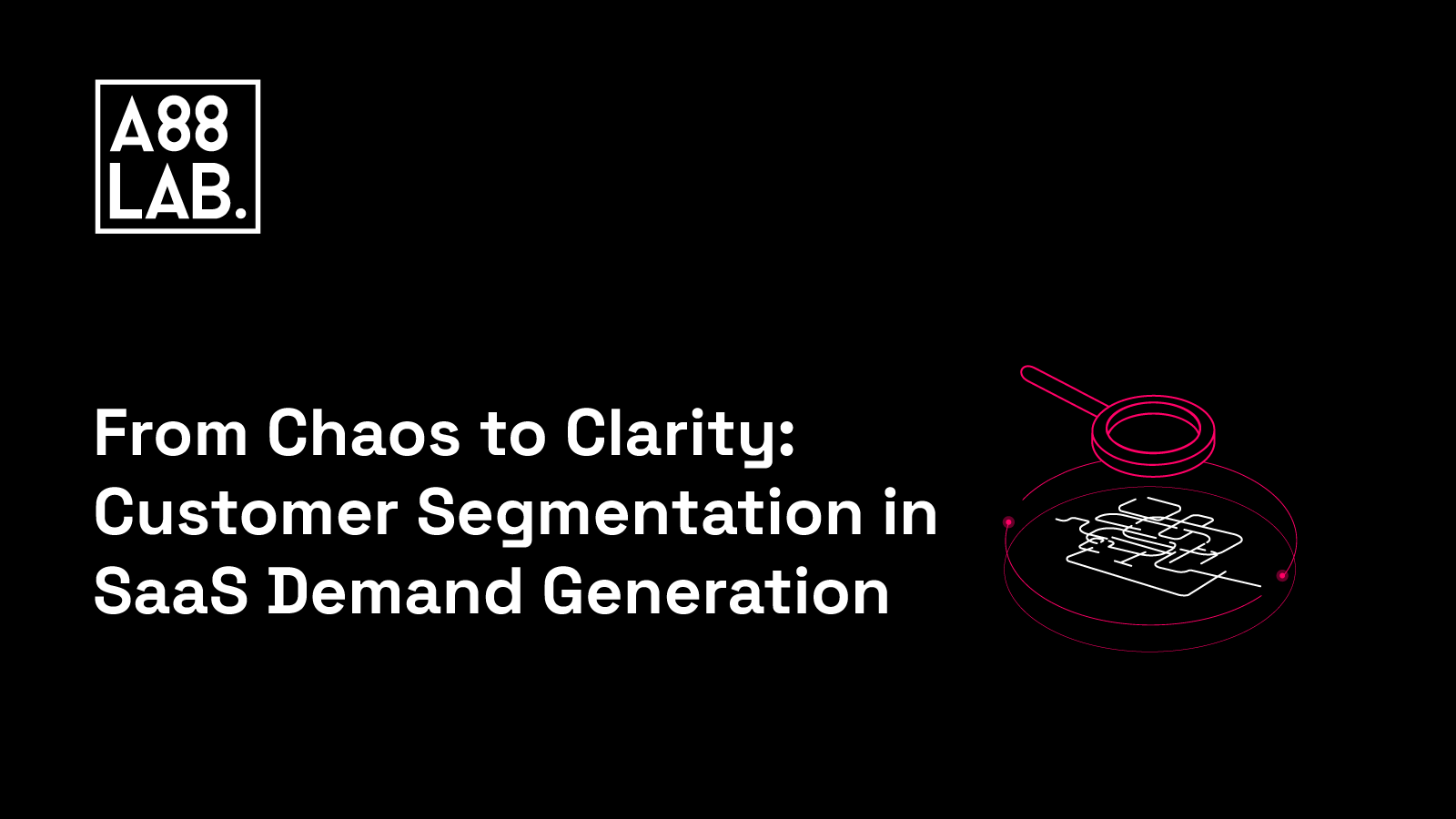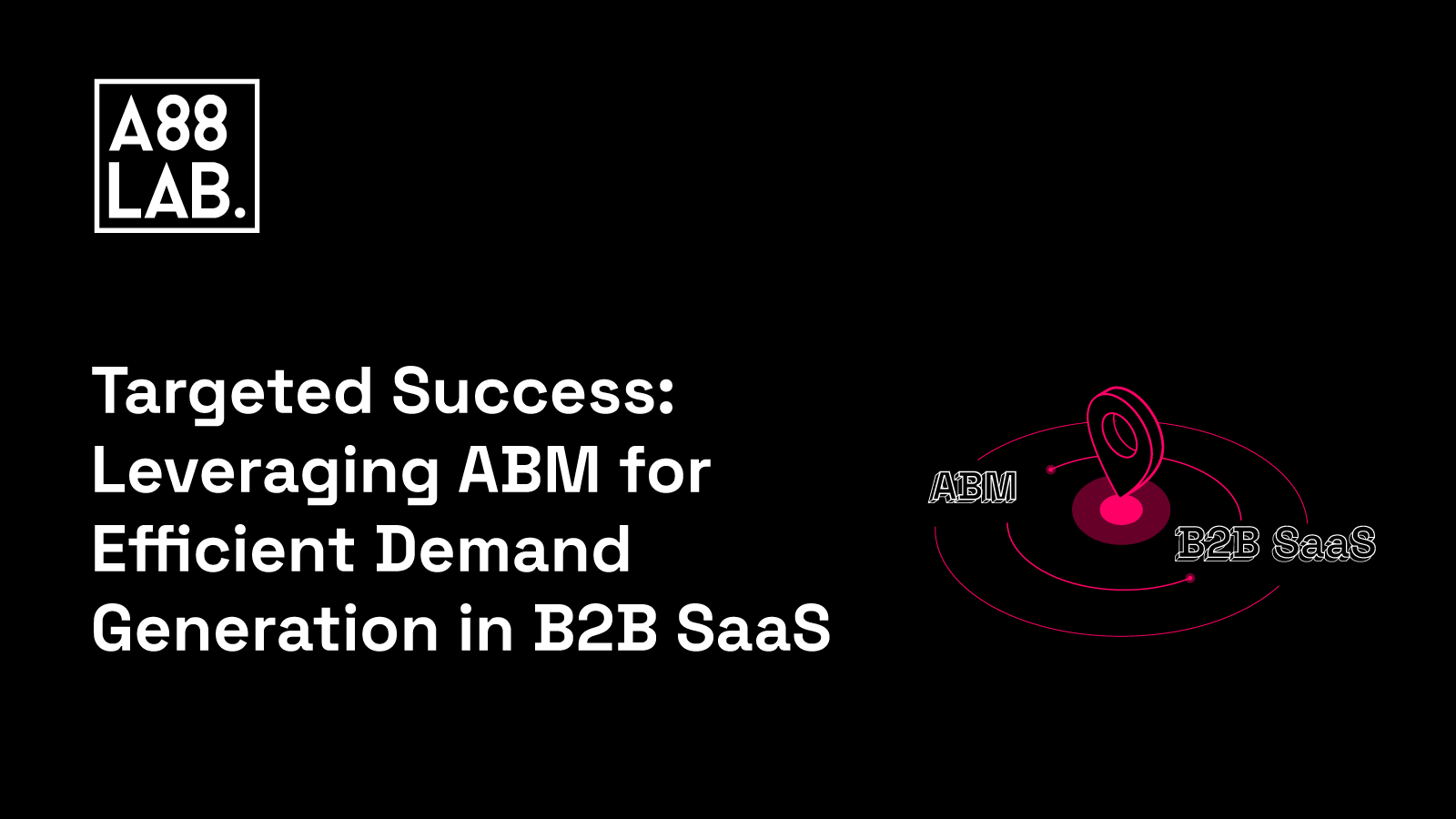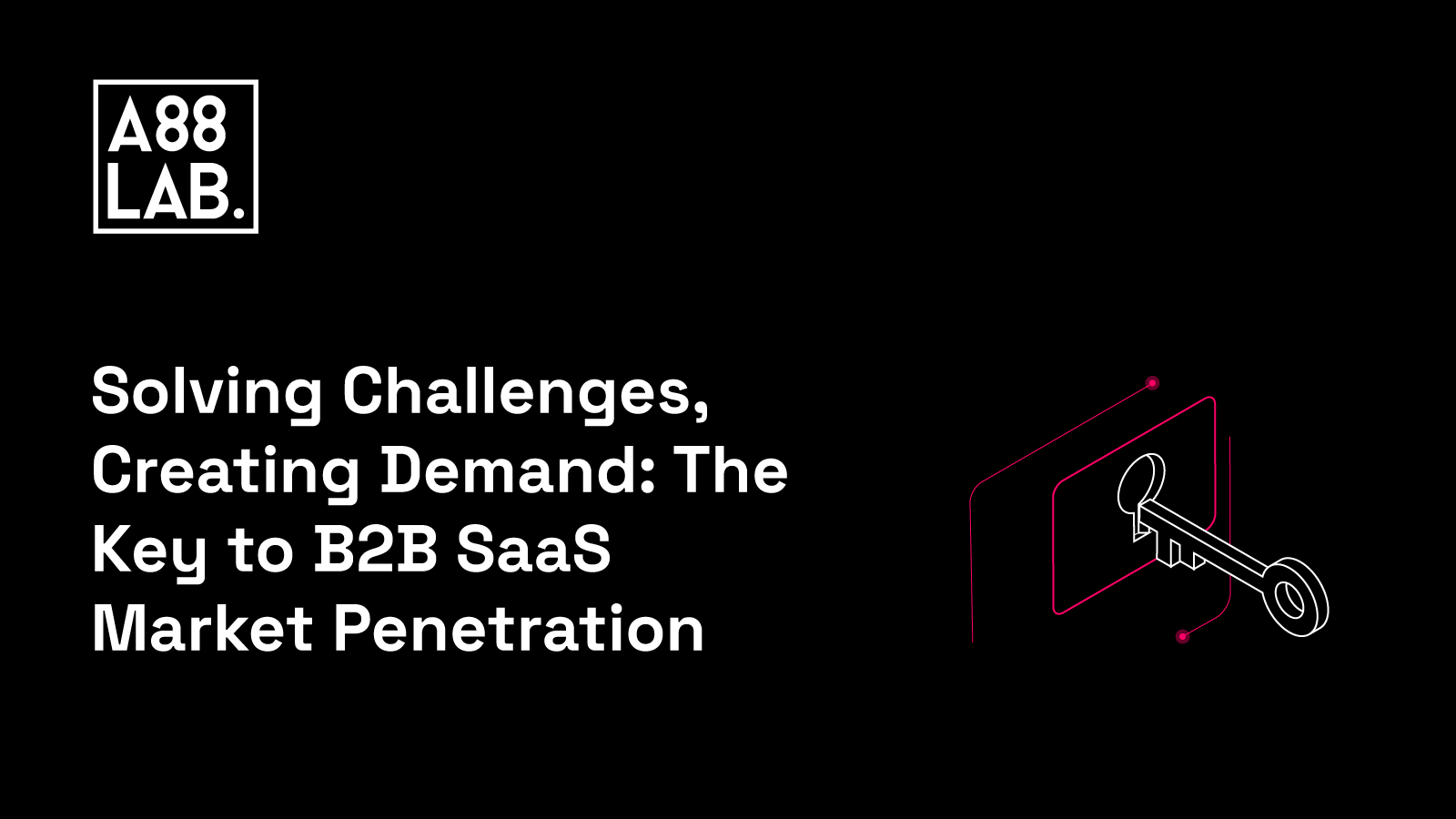In this blog post, we will explore the significance of customer segmentation in demand generation for B2B SaaS companies. We will dive into effective strategies for segmenting your customer base, including gathering insights from sales teams, conducting customer interviews, and conducting thorough industry research. We will also look at how to use segmentation data to create meaningful customer personas, ICPs and craft personalized messaging that resonates with prospects.
At the end of this post, you will have a better understanding of how customer segmentation makes a difference in your demand generation efforts and provide valuable insights into the needs and expectations of your target audience.
But let’s start from the beginning.
Imagine you've just launched a new B2B SaaS product, founded a new startup, or started a technology company. You have a great team and exciting ideas, and you know your solution has the potential to improve the way businesses operate.
But as you look out into the digital landscape, you realize that your roadmap for success is anything but clear. There is a huge amount of competition and just as many potential customers. They may be spread out across different industries, located in different geographic regions, and have varying needs.
In this kind of crowded, complex market, it's essential to know who you should be targeting and how, as reaching out to every single person with a generic message simply won't cut it. This is especially important if your product requires a significant investment or long-term commitment. To stand out, you will need to personalize both, your messaging and customer experience.
This is where customer segmentation comes in.
Customer segmentation is the art and science of breaking down your customer base into distinct groups based on shared characteristics, behaviors, and needs. Think of it as having a backstage pass to your target audience's inner thoughts and preferences. Understanding who your customers are, what they need from you, and how to reach them is key to creating an optimal customer experience.
Moreover, customer segmentation helps you to maximize the effectiveness of your demand generation activities by zeroing in on the right audiences, crafting more targeted messages, and building relationships with prospects.
Strategies for Successful Customer Segmentation
Let's look closely at some of the strategies for successful customer segmentation.
Identification of Target Markets
The first step in customer segmentation is to identify your target markets. This involves researching and understanding different industries, demographics, geography, job titles, and other factors that could lead to different customer segments.
Identifying target markets is a crucial component of successful customer segmentation and is necessary for various marketing strategies, from traditional mass marketing approaches to more targeted strategies like Account-Based Marketing (ABM).
How do you do it? Let's see:
Market research and analysis: Sit down and conduct comprehensive research into the industries, verticals, and niches you believe will benefit the most from your solution. Look for trends, pain points, and market opportunities that align with your product's value proposition.
Gathering insights from SDRs: Your sales development representatives (SDRs) are on the front lines, interacting with potential customers daily. Tap into their wealth of knowledge and experience by seeking their input on customer preferences, pain points, and objections. Their insights can be invaluable in shaping your customer segmentation strategy.
Conducting customer interviews: Take the time to engage directly with your existing customers or prospects through interviews. By asking targeted questions, you will gain deeper insights into their motivations, needs, and challenges. These interviews will help refine your customer segmentation and tailor your messaging accordingly.
Listening to customer calls: Dive into recorded customer calls or join live ones to truly understand your target audience's pain points and objections. These conversations provide real-time feedback and allow you to uncover insights that might not be readily apparent through other research methods.
Researching competitors and industry trends: Keep a close eye on your competitors and the broader industry landscape. By understanding how your competitors position themselves and the strategies they employ, you can identify gaps and opportunities within your target markets. Stay up-to-date with industry trends and developments to ensure your marketing efforts align with your audience's evolving needs and expectations.
Tailoring Marketing Messages and Channels
You did your research, and you believe you have a strong understanding of who your target customers are and what they need. Now it's time to create marketing messaging and content that resonates with them—and the only way to do that is to create meaningful customer personas.
Start by developing a detailed profile for each of your customer segments. Include demographics, habits and preferences, pain points, and anything else that could help inform your messaging. You can read more about creating B2B customer personas in our Inbound Marketing guide.
Once you've developed these customer personas, it's time to start crafting marketing messages tailored to them. To do this, it's important to focus on addressing their specific pain points, needs, and objections rather than solely focusing on revenue generation. Whether blog posts, case studies, whitepapers, or videos, your content should be personalized, demonstrate your understanding of their unique requirements, and, finally, be relatable and easy to digest.
It's also essential to determine the best channels for delivering your messages and content. Different customer segments will be active on different channels, so you need to select the ones that are most relevant for each of your personas. Whether it's email, social media, industry-specific forums, or online communities, knowing where your customers hang out will ensure you reach the right people with the right message.
Understanding Ideal Customer Profiles (ICPs)
In addition to creating customer personas, another crucial aspect of developing and executing a successful demand generation strategy is understanding Ideal Customer Profiles (ICPs). ICPs provide a more focused and targeted approach to identifying and engaging with the right customers for your business.
Let's delve a bit deeper into the significance of ICPs and how they contribute to your success.
Your ICPs are the ideal customer segments you want to target with your marketing messages and strategies. An ICP typically includes a combination of firmographic, demographic, psychographic, and technographic data that can be used to define an optimal audience for your product. To create an effective ICP, you must combine the data and insights you've gathered from customer personas with industry research.
This process will enable you to identify and understand the needs, wants, and pain points of your target customers on a more granular level. By understanding and leveraging this data, you can create more relevant and personalized content that resonates with customers.
Furthermore, ICPs provide valuable insights into the customer journey and help you optimize your marketing efforts across the entire funnel—from brand awareness to sales conversion. For example, ICPs can enable you to create highly targeted campaigns designed to reach a specific customer segment at each stage of their journey. This helps ensure that you're always pushing the right message, to the right market segment, at the right time.
Optimization of Marketing Campaigns
You've researched, you've segmented, and you've crafted personalized messages. Great job! But that still won't guarantee success. You may be biased in the way you see your product, and customers may not necessarily see it the same way. That's why it's important to keep testing and refining your strategies and campaigns.
Testing and refining marketing strategies: Use A/B testing and data analytics to experiment with different marketing strategies and messages. Measure and analyze the results to determine which approaches resonate the most with each customer segment.
Continuously refine and adapt your strategies based on the feedback and insights you gather, ensuring that your marketing efforts evolve alongside the needs and preferences of your target audience.
Allocating resources effectively: What should you focus your budget and marketing efforts on? What channels are delivering the most conversions and ROI? Which customer segments are providing the best results?
By continuously tracking, measuring, and analyzing the performance of your marketing campaigns, it's easier to determine where to allocate resources for maximum results.
Finally, it's important to remember that customer segmentation isn't a one-time process. As you capture more and more data over time, you can refine and improve your segmentation models. By continually revisiting and updating your personas, you can ensure that all of your marketing efforts are as effective and efficient as possible.
Common Customer Segmentation Methods
While there are a number of segmentation strategies you can choose from, some of the most popular include:
Demographic Segmentation: Segmenting customers based on demographic factors such as company size, industry, job role, and geographic location helps you understand the unique needs and preferences of different customer segments. This enables targeted marketing and personalized messaging that resonates with specific demographics.
Firmographic Segmentation: Segmenting customers based on firmographic data such as company size, industry, and revenue helps you identify high-value accounts and understand their specific requirements. This enables targeted marketing and personalized messaging that aligns with the unique needs of different firmographic segments.
Behavioral Segmentation: Analyzing customer behavior, including usage patterns, purchase history, and engagement with the product, provides insights into customers' preferences and interests. In turn, this allows you to tailor your marketing campaigns and product offerings to address specific behavioral segments, maximizing engagement and conversion rates.
Psychographic Segmentation: Understanding the values, motivations, and pain points of customers through psychographic segmentation is a great way to create personalized experiences and targeted messaging that resonates with specific customer segments. By aligning your offerings with customers' attitudes, interests, and aspirations, you will build stronger connections and foster customer loyalty.
Geographic Segmentation: Segmenting customers based on their geographic location will enable you to customize your marketing efforts to suit regional or local preferences and market conditions. By tailoring messages and campaigns to specific geographic segments, you can address unique market needs and establish a strong presence in different regions.
Each of these methods can provide valuable insights into your customers, and you may find that using a combination of methods gives you the most comprehensive view of your target audience.
Effective Targeting and Positioning Strategies
Once you've got your market segmented and landscape mapped, it's time to decide which segments you will focus on and which are better to be left for another day. You'll have to be strategic about it and focus on the segments that provide the most potential for growth and revenue.
You don't want to spread your resources too thin, so target the segments you believe you can make the most impact on. You'll also want to consider your own resources and capabilities and ensure that you have the capacity to meet the demands of the segments you are targeting.
Imagine you had the potential to make an impact in three different segments, but you only have the resources to focus on one of them. You'd want to weigh your options carefully - consider the size of each segment, the potential for growth, and your competitive advantage in each.
If you were to try and target all three segments with limited resources, you'd be running the risk of diluting your efforts, your message would become too generic, and results would take longer to achieve.
Once you've identified the segments to target, it's time to develop a positioning strategy. As Ries and Trout say, "Positioning is not what you do to a product. Positioning is what you do to the mind of the customer. It’s how you differentiate your brand in their mind."
That said, positioning doesn't mean you can say the most obvious thing about your product, but rather that you need to go deeper and find the unique angle. It all goes down to finding common ground between these areas:
- Your customer needs
- What your product delivers
- The competition in the space
Once you have a clear understanding and common ground between your customer needs, your product's unique attributes, and the competitive landscape, you can craft your positioning statement. This statement should be concise and memorable and convey the essence of what makes your product the best choice for your target segments. It should communicate your product's specific benefits, how it solves customer problems, and why it is superior to competing alternatives.
Remember, positioning is an ongoing process. As the market evolves and customer preferences change, you may need to adjust your positioning strategy to stay relevant. The key is regularly reviewing customer feedback, monitoring industry trends, and adjusting your strategy as needed.
Customer Segmentation Is the Foundation of Successful Demand Generation
Now that we’ve explored the various strategies for segmenting your customer base, let’s go back to basics and make sure you understand the importance of customer segmentation in fueling your demand generation initiatives.
A successful demand generation strategy can't exist without proper customer segmentation. How can you craft messaging that resonates with the right people if you don't clearly understand who they are and what motivates them? So, to create a successful demand generation strategy, that's highly focused and tailored to the right customer segments, you have to start with a comprehensive understanding of your customer base.
This, in turn, significantly increases your chances of building lasting relationships with your customers, ultimately leading to higher engagement and conversions in the long run. Basically, you can't generate demand without the right messaging and channels in place. And you can't have the right messaging and channels in place without customer segmentation.
Here are some of the key benefits that customer segmentation offers:
Avoids the “dangerous” average: Segmenting your customers helps you avoid the dangerous trap of the “average” customer. Instead of trying to craft a message that works for everyone, you can create more targeted messaging based on each segment's unique needs and preferences.
Increase personalization and relevance in messaging: If you know exactly what makes a segment of customers different, it becomes much easier to craft personalized messages that are tailored to their individual needs.
Improve targeting and conversion rates: Knowing who your target audience is and how to best reach them will help you focus your efforts on the segments that are most likely to convert. If most of your sales come from a few specific segments, you better adapt your strategy and focus your resources on those segments.
Enhance customer satisfaction and loyalty: By understanding each segment's preferences, you can tailor your product features, support services, and communication channels to meet their specific requirements. This level of personalization enhances customer satisfaction, fosters loyalty, and encourages customers to become advocates for your brand.
Challenges and Considerations in Customer Segmentation
As you get deeper into the world of customer segmentation, it's important to be aware of the various challenges and considerations that can arise during the process.
First, customer segmentation requires a significant investment in time and resources. You need to collect data, analyze it, and craft the right message for each segment. This takes both time and money, so weighing the potential benefits against the costs is important before committing.
Second, data privacy and ethical considerations play a crucial role in customer segmentation. As you collect and analyze customer data, it is essential to prioritize data privacy and adhere to ethical guidelines. Transparency in data collection, obtaining appropriate consent, and protecting sensitive customer information are all important elements of an ethical customer segmentation strategy.
Maintaining updated customer profiles is another challenge in customer segmentation. Customer preferences and behaviors evolve over time, necessitating regular updates to the segmentation criteria. Continuously collecting and analyzing customer data helps refine segments and stay aligned with changing market dynamics. Therefore, it is crucial to employ robust data management systems and strategies to ensure accurate and up-to-date customer profiles.
Finally, balancing broad targeting with individual personalization can easily become a challenge. While segmenting your target market allows you to tailor your marketing efforts, mass customization can be impractical or resource-intensive. Finding the right balance involves understanding which elements of your product or service can be personalized at scale and identifying key touchpoints to deliver relevant and personalized experiences.
There are many ways to navigate these challenges, from AI tools that automate data collection and analysis to creating customer journey maps that identify key touchpoints for personalization. Whatever path you decide to go down, remember that ethical data collection and customer privacy should remain your top priority.
Conclusion
At the end of the day, what effective customer segmentation boils down to is whether you are able to communicate the right message in front of the right people. By understanding the needs and preferences of different customer segments, you will be one step closer to the ideal customer experience.
However, it's important to remember that none of these strategies are set in stone. Market dynamics and customer preferences are ever-changing, so it's essential to stay agile and adapt your segmentation and positioning strategies accordingly. Keep an eye on industry trends, listen to your customers, and be open to refining your approach as needed.
.png)


